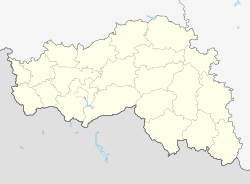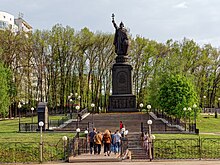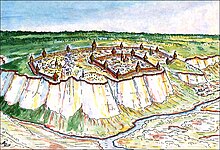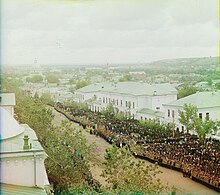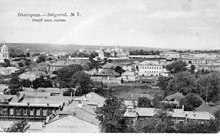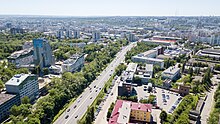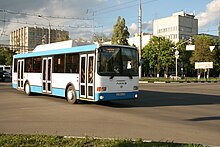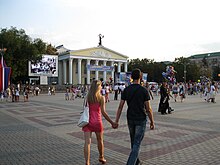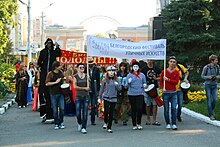
Stary Oskol is a city in Belgorod Oblast, Russia, located 618 kilometers (384 mi) south of Moscow. Population: 221,678 (2021 Census); 221,085 (2010 Census); 215,898 (2002 Census); 173,917 (1989 Census). It is called Stary Oskol to distinguish it from Novy Oskol located 60 kilometres (37 mi) south. Both are on the Oskol River.

Korocha is a town and the administrative center of Korochansky District in Belgorod Oblast, Russia, located on the right bank of the Korocha River, 57 kilometers (35 mi) northeast of Belgorod, the administrative center of the oblast. Population: 5,623 (2021 Census); 5,877 (2010 Census); 6,046 (2002 Census); 5,755 (1989 Census).

Grayvoron is a town and the administrative center of Grayvoronsky District in Belgorod Oblast, Russia, located on the shores of the Vorskla and Grayvoronka Rivers. Population: 6,179 (2021 Census); 6,234 (2010 Census); 6,196 (2002 Census); 5,992 (1989 Census). It was previously known as Grayvorony.
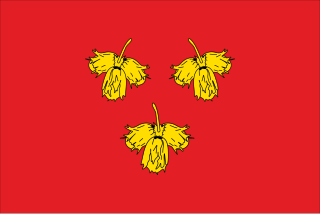
Krasnensky District is an administrative district (raion), one of the twenty-one in Belgorod Oblast, Russia. Municipally, it is incorporated as Krasnensky Municipal District. It is located in the northeast of the oblast. The area of the district is 851.9 square kilometers (328.9 sq mi). Its administrative center is the rural locality of Krasnoye. Population: 11,358 (2021 Census); 13,371 (2010 Census); 15,337. The population of Krasnoye accounts for 16.1% of the district's total population.

Belgorodsky District is an administrative district (raion), one of the twenty-one in Belgorod Oblast, Russia. Municipally, it is incorporated as Belgorodsky Municipal District. It is located in the southwest of the oblast, on the border with Ukraine. The area of the district is 1,472 square kilometers (568 sq mi). Its administrative center is the rural locality of Maysky. Population: 191,744 (2021 Census); 108,778 (2010 Census); 90,430 ; 68,870 (1989 Census). The population of Maysky accounts for 7.4% of the district's total population.

Borisovsky District is an administrative district (raion), one of the twenty-one in Belgorod Oblast, Russia. As a municipal division, it is incorporated as Borisovsky Municipal District. It is located in the west of the oblast. The area of the district is 650.3 square kilometers (251.1 sq mi). Its administrative center is the urban locality of Borisovka. Population: 23,904 (2021 Census); 26,252 (2010 Census); 26,282 ; 52,261 (1989 Census). The population of Borisovka accounts for 52.5% of the district's total population.

Grayvoronsky District is an administrative district (raion), one of the twenty-one in Belgorod Oblast, Russia. Municipally, it is incorporated as Grayvoronsky Municipal District. It is located in the west of the oblast. The area of the district is 853.8 square kilometers (329.7 sq mi). Its administrative center is the town of Grayvoron. Population: 29,137 (2010 Census); 31,567. The population of Grayvoron accounts for 21.4% of the district's total population.

Gubkinsky District is an administrative district (raion), one of the twenty-one in Belgorod Oblast, Russia. It is located in the north of the oblast. Its administrative center is the town of Gubkin. Population: 33,561 (2010 Census); 33,974 ; 33,809 (1989 Census).
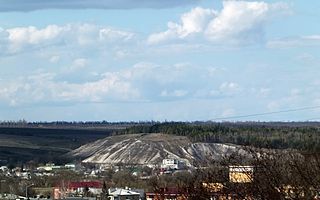
Korochansky District is an administrative district (raion), one of the twenty-one in Belgorod Oblast, Russia. As a municipal division, it is incorporated as Korochansky Municipal District. It is located in the center of the oblast. The area of the district is 1,464.1 square kilometers (565.3 sq mi). Its administrative center is the town of Korocha. As of the 2021 Census, the total population of the district was 35,883, with the population of Korocha accounting for 15.7% of that number.

Krasnoyaruzhsky District is an administrative district (raion), one of the twenty-one in Belgorod Oblast, Russia. Municipally, it is incorporated as Krasnoyaruzhsky Municipal District. It is located in the west of the oblast. The area of the district is 479.2 square kilometers (185.0 sq mi). Its administrative center is the urban locality of Krasnaya Yaruga. Population: 14,151 (2021 Census); 14,891 (2010 Census); 15,128. The population of Krasnaya Yaruga accounts for 56.2% of the district's total population.

Starooskolsky District is an administrative district (raion), one of the twenty-one in Belgorod Oblast, Russia. It is located in the north of the oblast. The area of the district is 1,694 square kilometers (654 sq mi). Its administrative center is the city of Stary Oskol. Population: 35,457 (2010 Census); 35,063 ; 35,266 (1989 Census).

Valuysky District is an administrative district (raion), one of the twenty-one in Belgorod Oblast, Russia. As a municipal division, it is incorporated as Valuysky Municipal District. It is located in the south of the oblast. The area of the district is 1,709.6 square kilometers (660.1 sq mi). Its administrative center is the town of Valuyki. Population: 33,845 (2010 Census); 36,601 ; 38,293 (1989 Census).

Veydelevsky District is an administrative district (raion), one of the twenty-one in Belgorod Oblast, Russia. Municipally, it is incorporated as Veydelevsky Municipal District. It is located in the southeast of the oblast. The area of the district is 1,356 square kilometers (524 sq mi). Its administrative center is the urban locality of Veydelevka. Population: 21,332 (2021 Census); 21,670 (2010 Census); 24,555 ; 24,108 (1989 Census). The population of Veydelevka accounts for 34.4% of the district's total population.
Oktyabrsky is an urban-type settlement in Belgorodsky District of Belgorod Oblast, Russia. Population: 8,785 (2021 Census); 7,456 (2010 Census); 6,899 (2002 Census); 6,421 (1989 Census).

Urazovo is an urban-type settlement in Valuysky District of Belgorod Oblast, Russia. Population: 6,570 (2021 Census); 6,982 (2010 Census); 6,878 (2002 Census); 6,345 (1989 Census).
Pyatnitskoye is an urban-type settlement in Volokonovsky District of Belgorod Oblast, Russia. Population: 4,160 (2021 Census); 4,536 (2010 Census); 4,793 (2002 Census); 4,528 (1989 Census).
Proletarsky is an urban-type settlement in Rakityansky District of Belgorod Oblast, Russia. Population: 9,040 (2021 Census); 8,654 (2010 Census); 8,675 (2002 Census); 8,167 (1989 Census).
Maslova Pristan is an urban-type settlement in Shebekinsky District of Belgorod Oblast, Russia. Population: 5,916 (2021 Census); 5,819 (2010 Census); 5,597 (2002 Census); 4,052 (1989 Census).
Tomarovka is an urban-type settlement in Yakovlevsky District of Belgorod Oblast, Russia.
Yakovlevo is an urban-type settlement in Yakovlevsky District of Belgorod Oblast, Russia. Population: 2,675 (2021 Census); 2,906 (2010 Census); 2,596 (2002 Census); 2,544 (1989 Census).





